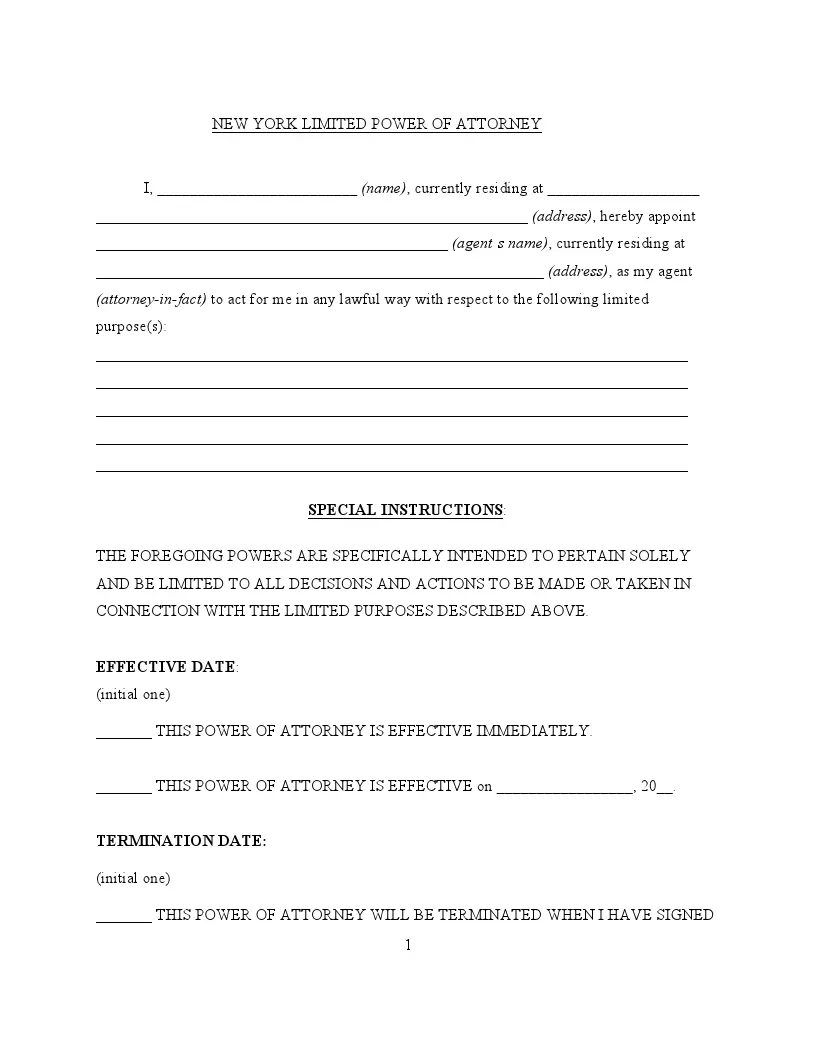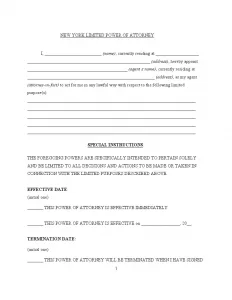New York Limited Power of Attorney Form
The New York limited power of attorney grants a person, referred to as the agent, the authority to act on behalf of another, known as the principal, under specific, restricted conditions. This legal instrument is tailored to suit precise tasks or events, such as managing financial transactions or real estate dealings.
A limited power of attorney in New York is quite specific and usually ends once the task it was set up for is done or when a specific date arrives. This setup helps people handle just the parts of their affairs without giving away too much control over all their financial or legal matters. It’s really handy for anyone who needs a bit of help with certain affairs but still wants to keep the reins on their overall situation.
For those needing to handle specific legal tasks, using New York power of attorney forms provides the necessary authorization in a legally recognized manner.

Build Your Document
Answer a few simple questions to make your document in minutes
Save and Print
Save progress and finish on any device, download and print anytime
Sign and Use
Your valid, lawyer-approved document is ready
In New York, the legal framework for signing a limited power of attorney is guided by specific statutes and definitions that ensure the process is carried out correctly and securely. According to the Consolidated Laws of New York – Chapter 24A – Article 5, anyone designated as an “agent” is given the authority to act on behalf of someone else, known as the “principal.” This designation involves a fiduciary duty, meaning the agent must act in the principal’s best interests.
Signing requirements for a limited power of attorney in New York are as follows:
- Two disinterested witnesses must be present to observe the signing of the document.
- A notary public must also witness the signatures and provide an official notarization.
These steps, specified in § 5-1501B, are essential for ensuring the power of attorney is valid. The presence of impartial witnesses and a notary can deter fraud and guarantee that the principal’s wishes are clearly expressed and legally documented.
New York Limited Power of Attorney Form Details
| Document Name | New York Limited Power of Attorney Form |
| Other Name | New York Special Power of Attorney |
| Relevant Laws | Consolidated Laws of New York, Sections 5-1501 – 5-1514 |
| Avg. Time to Fill Out | 8 minutes |
| # of Fillable Fields | 32 |
| Available Formats | Adobe PDF |
Filling Out New York Limited POA
Completing a limited power of attorney form in New York allows you to grant specific legal powers to an agent to act on your behalf under precise conditions. Here’s how to accurately fill out this document in nine detailed steps.
1. Understanding the Form
Begin by thoroughly reading the document to understand the scope and implications of granting a limited power of attorney. Note that this power of attorney will enable your chosen agent to perform specific tasks like managing financial transactions or property on your behalf.
2. Designating Your Agent
Identify and appoint your agent (or attorney-in-fact) who can act on your behalf. Write the full name and address of the agent in the designated section on the form. Choosing someone you trust is crucial, as they will manage aspects of your affairs.
3. Appointing Successor Agents (Optional)
If desired, you can appoint a successor agent who will take over if your primary agent is unable to perform their duties. Fill in the names and addresses of any successor agents and specify if they can act separately or must act jointly.
4. Specifying the Powers Granted
Mark the specific powers you are granting to your agent. These can range from handling certain financial accounts to selling property. Be explicit about what the agent can and cannot do.
5. Setting Effective Date and Termination
Determine when the limited power of attorney will come into effect. You can choose to have it effective immediately or start on a specific date. Also, decide when a power of attorney will terminate — on a specific date, upon your revocation, or under other circumstances like your incapacitation.
6. Signing the Form
Once all sections are completed, sign the form in the presence of two disinterested witnesses and a notary public. Your signature must be done voluntarily and with an understanding of the document’s significance.
7. Witness and Notary Acknowledgment
Have the two witnesses sign the form, confirming that they observed you signing the document and that you did so willingly. Then, the notary public will verify your identity and acknowledge your signature.
8. Providing Copies to Relevant Parties
After notarization, provide copies of the signed and notarized document to your agent, any successor agents, and perhaps a legal advisor for safekeeping. If applicable, notify institutions or individuals affected by the limited power of attorney.
9. Revocation or Amendment
You can revoke or amend the power of attorney anytime, provided you are mentally competent. To do this, you must give written notice to your agent and any institutions relying on the original document.
